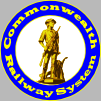Jack Naugler
Basic Definitions:
A Consist is a group of two or more locomotives running as a single unit. The term ‘Consist’ is usually applied to diesel locomotives. When applied to steam locomotives, it’s usually called ‘Double-heading’ or ‘Triple-heading’.
Basic Consisting
All units are programmed to the same address. This method is most useful when the locos in question will always run as a set. Locos cannot be added to or removed from the consist ‘on the fly’. Any units that must run backwards as part of the set must have their NDOT (Normal Direction Of Travel) bit set in CV29. Any function commands sent will be responded to by all locos. (You cannot have independent control of lights, bell, horn, etc.)
Universal Consisting
This a feature of Digitrax systems (and maybe others) where a consist can be made up and stored in the command station. Locos can be added to or removed from the consist easily. Although loco movement is controlled by the consist lead, individual locos can be addressed to turn various functions on or off (headlights, horns, bells, etc.). This method of consisting is the most often used at PSMRC.
Advanced Consisting
For those decoders that support it, CV19 is the consist address. When CV19 contains 0, the locomotive responds to its normal short or long address. (as defined by CVs 1, 17 & 18 and 29) When CV19 contains 1 to 127, the locomotive responds to that address rather than its normal short or long address. Adding 128 to the address in CV19 reverses the direction of that loco. Some decoders that implement CV19 as the consist address also use CV21 and CV22 to control which functions remain active in consist mode.
What you need to know before making up a consist
- Do the locos you want to consist run well together? If not, you may want to speed-match them or set custom speed tables using CVs 65-95.
- Locomotives in consist do not have to be identical, or have the same decoders, but if they are and do, it makes life much easier.
- Some sound decoders pause before turning on the motor while the prime mover revs up. This is realistic with diesels, but with no pause in silent decoders, consisting becomes difficult.
- Know the capabilities and limitations of your decoders
- Ops Mode Programming/Programming on the Main
- Basic Speed Control 3 Point Speed Table (CV 2, 5 and 6)
- Enhanced Speed Control 28 speed step table (CV 65-95)
- Do the decoders support CV19? Some older ones do not.
Basic Consisting
- Program the locos to the same address. Use whatever programming procedure you desire.
- Don't forget to set the direction bit in CV 29
- Run 'em.
Universal Consisting
- Assign a loco as the 'Top Loco' (head of consist) to the right throttle on a controller.
- Assign the loco to be added to the left throttle,
- Make sure loco directions are the same, then press the 'MU' button
- Press the 'Y' button, then the 'Enter' button
- Repeat the last 3 steps to add more locos to the consist.
- All motor control will be via the 'Top' Address
- Loco functions (Lights, bell, horn, etc.) are controlled via the loco's native address
- When done, break up the consist and release the locomotives
Advanced Consisting
- CV19 is the Consist address, address range is 1 – 127, 0 is Off, 129 - 255 are the same as 1 – 127, but in reverse.
- CV21 and CV22 settings determine whether the loco address or the consist address controls functions. Each CV behaves as a bank of individual on-off switches which determine whether a function will be controlled by the loco address or the consist address.
- CV21 has the switches for F1 thru F8
- CV22 has the switches for F0f and F0r (the headlights front and rear), and F9 thru F12.
- Be aware that while CV19 can usually be programmed on the main, in some cases, CV21 and 22 can not be. This means that the functions you want active at the consist address must be pre-selected and programmed on the programming track.
Consisting Questions
Consisting Examples


Wiring Switches
Last Modified on January 12, 2012
